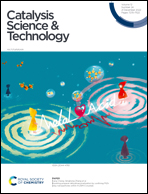Visible-light-induced photocatalytic reductive carbonylation of nitroarenes using formic acid as a hydrogen source over a water-dispersible CTF-based palladium catalyst†
Abstract
In the present study, Pd nanoparticles (NPs) supported on α-Fe2O3-decorated melamine-based COFs (Pd/α-Fe2O3@CTF) were employed as photocatalysts for water-mediated photocatalytic one-pot reductive N-formylation of nitroarenes using HCOOH as a sustainable hydrogen and formylation source under visible light irradiation. The desired products were obtained in good to excellent yields at room temperature. The high photocatalytic performance over Pd/α-Fe2O3@CTF was ascribed to redshift absorption in the visible-light region compared to pure CTF, resulting in the enhancement of photocatalytic activity under visible light. By combining CTF with inorganic semiconductor α-Fe2O3, which has significant and widespread visible light absorption, a hybrid heterostructure that increases the photocatalytic activity can be created. Moreover, Pd incorporation can also boost the photogenerated electron–hole separation efficiency. Pd/α-Fe2O3@CTF was found to be photostable and could be reused five times without any loss of its activity.



 Please wait while we load your content...
Please wait while we load your content...